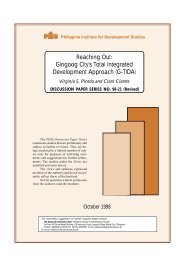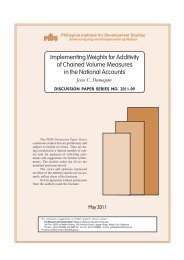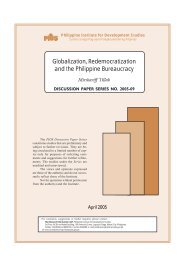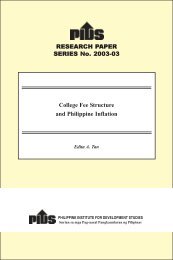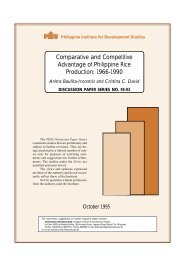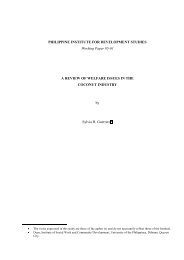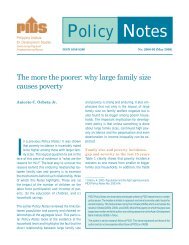Conditional Cash Transfer Program in the Philippines: Is It Reaching ...
Conditional Cash Transfer Program in the Philippines: Is It Reaching ...
Conditional Cash Transfer Program in the Philippines: Is It Reaching ...
Create successful ePaper yourself
Turn your PDF publications into a flip-book with our unique Google optimized e-Paper software.
to provide cash assistance to <strong>the</strong> poor to alleviate <strong>the</strong>ir immediate need (short term povertyalleviation); and (ii) Social Development - to break <strong>the</strong> <strong>in</strong>tergenerational poverty cycle through<strong>in</strong>vestments <strong>in</strong> human capital. <strong>It</strong> helps to fulfill <strong>the</strong> country’s commitment to meet <strong>the</strong>Millennium Development Goals, namely: (1) eradicate extreme poverty and hunger, (2) achieveuniversal primary education, (3) promote gender equality, (4) reduce child mortality, and (5)improve maternal health.The 4Ps offers 6,000 pesos annually (P500 per month) for each household selected by <strong>the</strong>programme for health and nutrition expenses. Also, it provides 3000 pesos per child for oneschool year (i.e. 10 months) or 300 pesos per month for educational expenses. Only up to amaximum of three children for each household can receive a subsidy. In return, <strong>the</strong> conditionsthat are to be met by beneficiaries are that - 1) pregnant women must avail of pre- and post-natalcare and be attended dur<strong>in</strong>g childbirth by a tra<strong>in</strong>ed health professional; 2) parents must attendfamily development sessions; 3) 0-5 year old children must receive regular preventive healthcheck-ups and vacc<strong>in</strong>es; 4) 3-5 year old children must attend day care or preschool classes atleast 85% of <strong>the</strong> time; 5) 6-14 year old children must enroll <strong>in</strong> elementary or high school andmust attend at least 85% of <strong>the</strong> time; and 6) 6-14 years old children must receive de-worm<strong>in</strong>gpills twice a year (DSWD website). The household beneficiaries will receive <strong>the</strong> subsidy, so longas <strong>the</strong>y comply with <strong>the</strong> conditionalities, for at most five years.The eligible beneficiaries are selected by DSWD from <strong>the</strong> poorest municipalities basedon <strong>the</strong> 2003 Small Area Estimates (SAE) of poverty <strong>in</strong>cidence generated by <strong>the</strong> NSCB.Municipalities with poverty <strong>in</strong>cidence higher than or equal to 50 percent are saturated – that is,all families are <strong>in</strong>terviewed and assessed for eligibility. In municipalities where <strong>the</strong> poverty<strong>in</strong>cidence is less than 50 percent, “pockets of poverty” are identified by <strong>the</strong> municipal socialwelfare and development officer and <strong>the</strong>n families <strong>in</strong> <strong>the</strong>se pockets are <strong>in</strong>terviewed and assessedfor eligibility. Families resid<strong>in</strong>g outside <strong>the</strong>se pockets of poverty are excluded <strong>in</strong> <strong>the</strong> assessmentanymore. This may lead to significant exclusion.Eligible households have <strong>in</strong>come that are equal to or below <strong>the</strong> prov<strong>in</strong>cial poverty l<strong>in</strong>e,have children 0 to 14 years old and/or a pregnant woman at <strong>the</strong> time of assessment; and thosewho agree to meet <strong>the</strong> conditions of <strong>the</strong> program.To obta<strong>in</strong> <strong>the</strong> poorest households <strong>in</strong> <strong>the</strong> municipalities, <strong>the</strong> DSWD uses <strong>the</strong> NationalHousehold Target<strong>in</strong>g System for Poverty Reduction (NHTS-PR). The system employs ProxyMeans Test Model to identify <strong>the</strong> poor families. The Proxy Means Test model was estimatedus<strong>in</strong>g data from <strong>the</strong> 2006 Family Income and Expenditure Survey and <strong>the</strong> 2006 Labor ForceSurvey. The assessmentt is conducted by us<strong>in</strong>g certa<strong>in</strong> proxy variables like ownership of assets,type of hous<strong>in</strong>g, education of household head, livelihood and access to water and sanitationfacilities to predict <strong>in</strong>come. To verify compliance, <strong>the</strong> DSWD coord<strong>in</strong>ates with <strong>the</strong> program’s3





